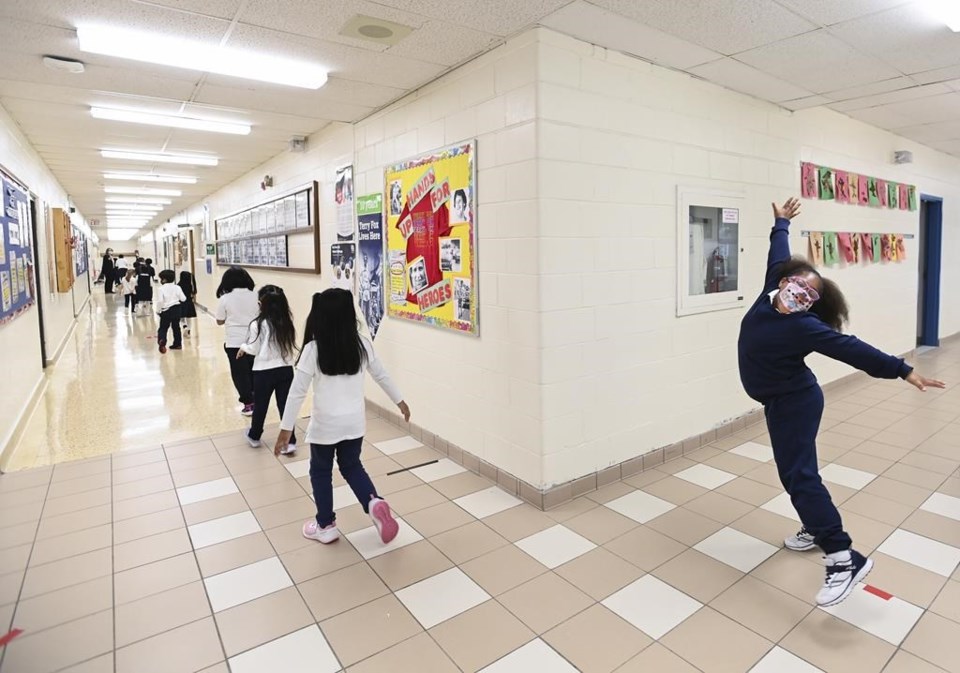TORONTO — Experts at a leading children's hospital say schools need to ramp up COVID-19 testing and masking in order to have all kids return safely to the classroom as soon as possible.
The guidance comes a day after Ontario said it would allow just seven public health units in southern Ontario to resume in-person learning Monday, while students in hot-spot regions will continue with online learning until at least Feb. 10.
Northern regions returned to the class last week, but areas including Toronto and Peel were deemed too-high risk.
Thursday's guidelines, led by experts at Toronto's Hospital for Sick Children, urge COVID-19 tests for all staff and students exposed to a case, and that indoor masking be made mandatory for all those Grade 1 and up.
Report co-author and SickKids president Dr. Ronald Cohn said current protocols only require tests for those with symptoms, and that's not good enough.
"We need much more rigorous systematic testing in place for everybody who had a contact," said Cohn.
"That's missing right now and that's key information that we need (in order) to identify areas where we need to improve health and safety measures, but also to collect this data that we just don't have in Ontario."
Cohn acknowledged this could further burden provincial labs but said there was capacity to increase tests.
Cohn also noted the preferred method of COVID-19 testing – in which a nasopharyngeal swab is inserted deep into the nose – may be especially tough to get from wriggling children and so less invasive samples such as saliva could be considered to encourage co-operation.
Ontario's associate chief medical officer Barbara Yaffe suggested plans were already afoot to consider such a move, and that the government has experimented with expanded testing.
She said a pilot exercise back in November offered tests to entire cohorts sent home because of a case, as well as family members of the students.
The positivity rate was around two per cent, "which is very low," she said.
"We're looking at maybe continuing to do that when we open schools," said Yaffe, adding the deployment of rapid tests was also being considered.
Cohn urged a slew of "bundled" infection control measures to limit school disruption he said has taken a toll on the physical and mental health of many young people, as well as exacerbated social inequities.
The experts urged kindergartners be allowed to play and interact with their peers without the same distancing requirements of older children, as long as they were cohorted to limit contacts. Masks should also be encouraged in this group, if possible.
However, Cohn said masks should not be an option for older children – not just middle and high school students but also elementary students.
He noted that extending mask mandates to elementary children was a point of contention among the group.
"We have 39 experts who have contributed to our document and probably the most controversial question around getting consensus was around masking," said Cohn.
He said school safety will depend on a mix of suppression tactics.
"If everybody is going to wear a mask but we don't consider other aspects like cohorting, screening, hand-washing, ventilation, then the mask itself is not going to make a huge difference either," said Cohn.
The experts said targeted one-time surveillance tests to find pre-symptomatic and asymptomatic children could be useful if the chance of infection is high, but otherwise was not recommended.
They also discouraged the use of rapid tests using molecular or antigen tests because of their lower sensitivity and less effectiveness with asymptomatic cases.
Yaffe agreed that kids in school should be a priority, but said positivity rates spiked among children after the holidays and that transmission was so high a lockdown was deemed safest.
"We do have a lot of layers of protection in the schools but if the community infection rate is high, that's where it comes into the schools," said Yaffe.
"It's not a simple situation. We're continuing to monitor very carefully and put in more measures as appropriate."
This report by The Canadian Press was first published Jan. 21, 2021.
Cassandra Szklarski, The Canadian Press
